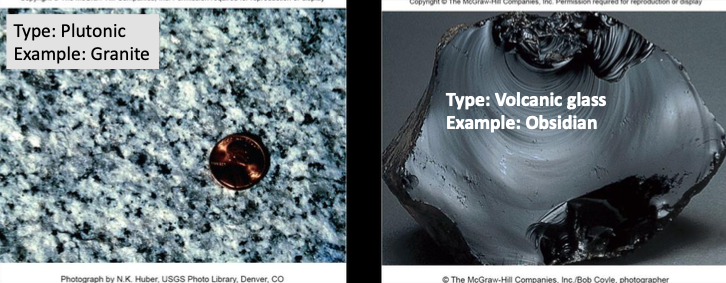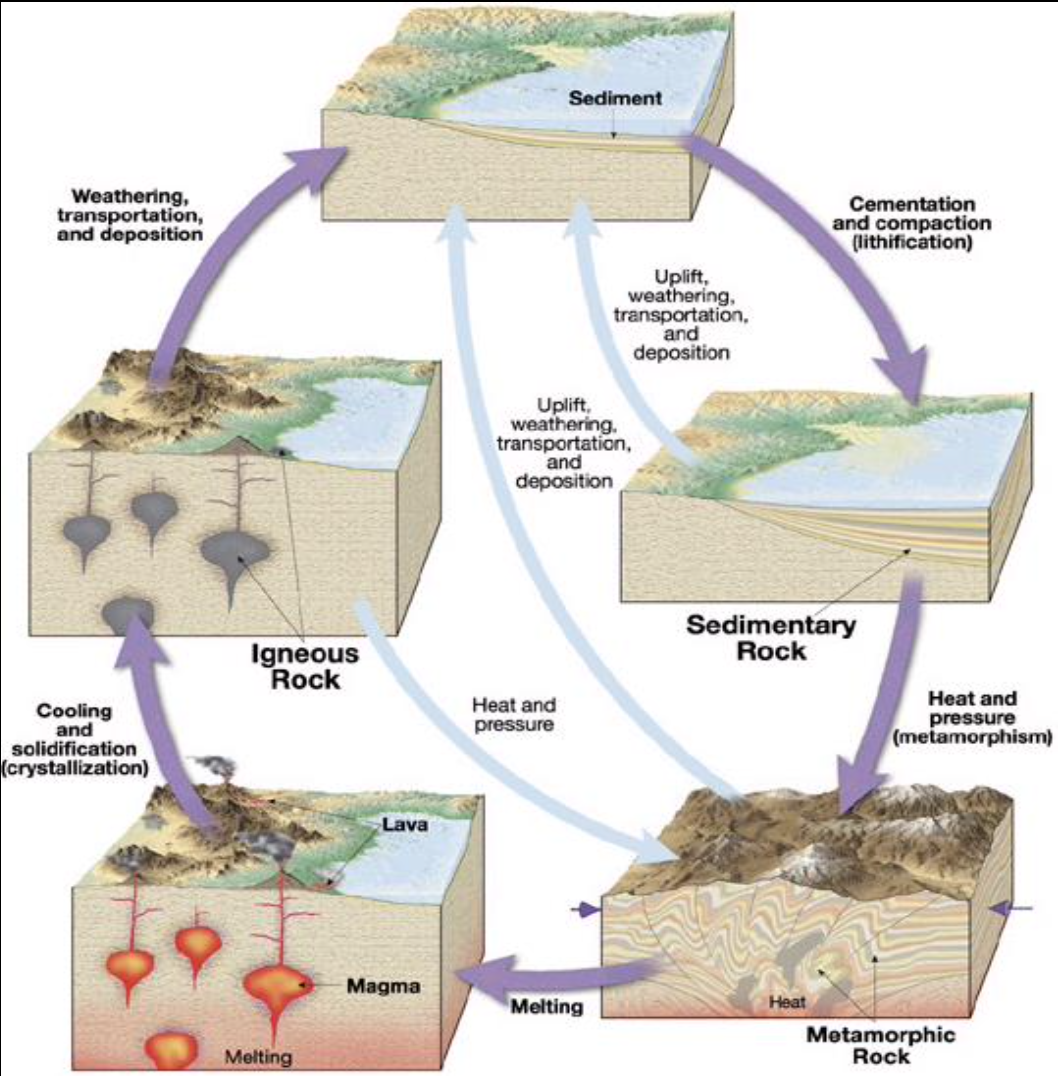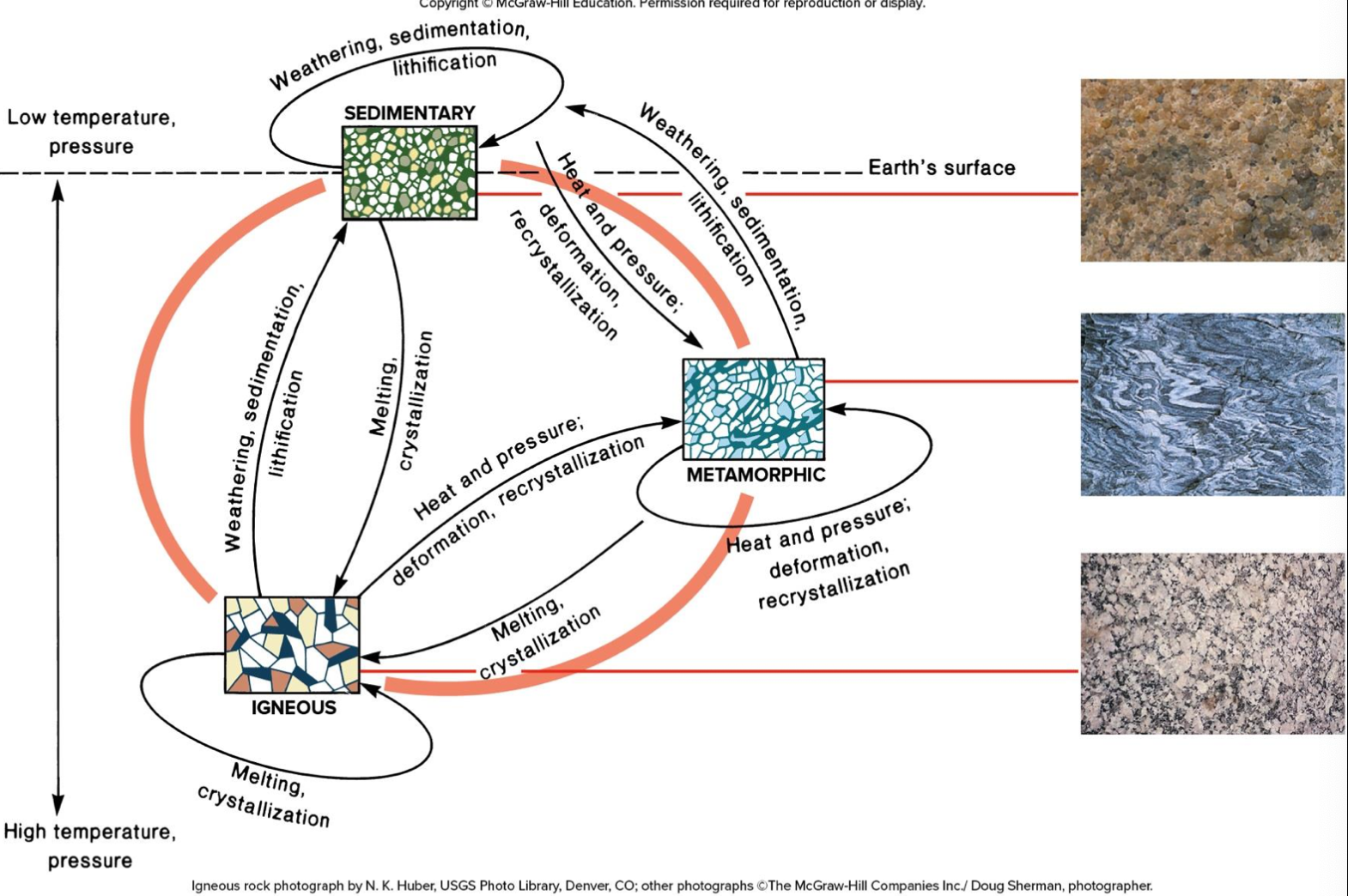Rocks
Rocks are formed from Minerals.
- A solid aggregate of one or more minerals, or mineral materials
- Consists of many mineral grains or crystals forming a solid mass
- Rocks are always subject to change! Each rock contains a record of its own history (i.e., formation or alternation due to external processes or forces)
Types of Rocks
Three broad rock categories based on their formation.
- Igneous - solidification and crystallization of cooling magma
- Sedimentary - lithification (cementing) of sediments
- Metamorphic - formed from another rock following and / or pressure
Igneous
Where do igneous rocks come from?
Magma is found under the Earth’s surface as hot molten (liquid) rock. Lava is magma which has erupted through the crust and is now on the Earth’s surface.
- Plutonic: Magma way below the surface cools very slowly, allowing crystals to grow large, and be seen with naked eye ⇒ Granite
- Volcanic: Magma (lava) near the surface cools rapidly, less time for crystals to grow large, looks like glass ⇒ Obsidian

- Volcanic: Most common volcanic rock (ocean floor), cooled a bit slower than glass, dark because of ferromagnesian minerals and feldspar ⇒ Basalt
- Volcanic: Crystallization starts slowly at depth and some large crystals grow, then rapid cooling happens (e.g., eruption) and rest is fine-grained ⇒ Porphyry
Sedimentary
Think of the Grand Canyon.
Sedimentary rocks
Are composed of sediments.
- Sediment are produced by weathering of pre-existing rocks and minerals
- And are loose, unconsolidated accumulations of mineral or rock particles
- Sediments then experience Lithification
- Compacting of sediments by burial and cementation of them
- The result is a sedimentary rock
Types of Sedimentary Rocks:
- Clastic sedimentary rocks
- Formed by lithification of mechanically weathered pieces of rocks and minerals
- Grains are continually broken down in size and shape until deposited
- Once deposited these clastic particles are cemented
- Chemical sedimentary rocks
- Formed from products of chemical processes occur in water bodies
- Minerals precipitate from the water and form thick deposits
- Examples: Halite (NaCl), Calcite (CaCO3)
- Shells of marine animals
Coal is a sedimentary rock
- But not from minerals
- From organic sediments (land plants)
Metamorphic
Comes from Greek for “changed form”.

Metamorphic Rocks
From the transformation of other rocks because of heat, pressure, or fluids while remaining in solid state.
Heat increases as a rock is buried or is close to magma chamber
Pressure increases with burial or collision between moving continents
Fluids become heated and circulate with burial or with location near a magma chamber
- Temperature and pressure causes minerals to recrystallize (but not melt)
- Pressure causes deformation

Types of metamorphism:
- Contact
- localized metamorphism of rocks adjacent to a magma chamber
- Regional
- large scale stressing and heating of a rock by deep burial or continental plates moving and colliding

Common Metamorphic Rocks:
- Marble
- Metaconglomerate
- Quartzite
- Garnet amphibolite
The Rock Cycle

Understand the rock cycle and how you can go through/between those cycles.

- Relationship between the Earth’s internal and external processes and the three major rock groups
- Rocks undergo change!
Rock Deformation
How Rocks Deform?
- Stress - force being applied externally
- Compressive stress squeezes an object
- Tensile stress stretches and object
- Shear stress acts along a plane causing stress in different directions
- Strain - deformation resulting from stress
- Elastic deformation / behaviour - proportional to stress and will return to original state when stress relieved
- But materials have an elastic limit that once passed will cause plastic deformation, which is not reversible
- But many materials do have a rupture point when enough stress occurs
- Rocks are ductile, can undergo plastic deformation without breaking
- Brittle materials rupture before plastic deformation (low temp & pressure)